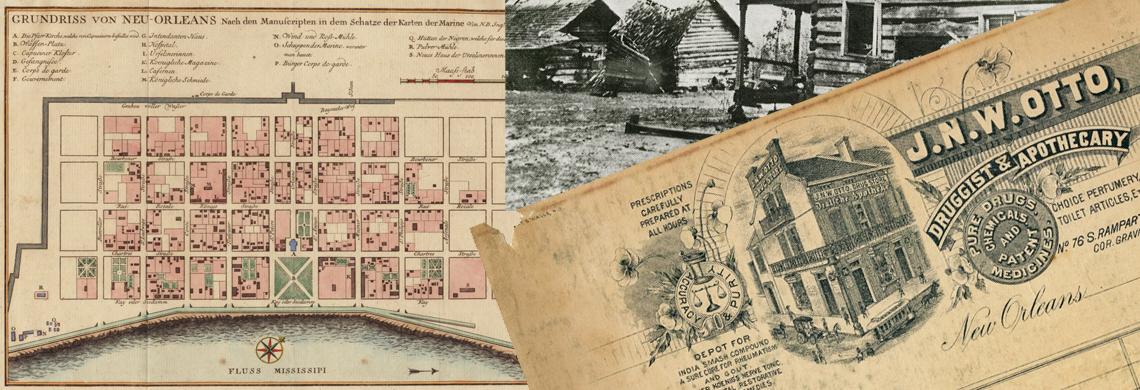Introduction
This pathfinder is intended to guide interested researchers to diverse materials available at the Williams Research Center (WRC) of The Historic New Orleans Collection that concern the Germans of New Orleans. From the first German settlers who came to the region in the 1720s to institutions that still exist today, the people, organizations, and activities presented here tell the story of a community that has understood itself as such for nearly as long as there has been a place called Louisiana. Indeed, through economic activity and cultural contributions, it is a community that helped create the very definition of Louisiana and New Orleans, even if that contribution has often been made from the margins. While the materials compiled here will include something of interest for the vast majority of researchers of this field, it is necessary to keep in mind that THNOC’s holdings are always growing. Also, as lengthy as the history of Germans in this region is, and as assimilated as they have often been, there are most certainly THNOC materials not touched upon here that relate in some way to someone or something German.
Manuscript materials form the heart of THNOC’s German-related holdings: the Deutsches Haus Collection (MSS 609) and the archives of the Germania Lodge No. 46 Free Masons (EL2.2001), both on extended loan from the respective organizations, are the largest single collections. Some other manuscripts holdings of note are the J. Hanno Deiler Papers (MSS 395), the German Protestant Orphan Asylum Association Records (MSS 402), the Faust Family Papers (MSS 479), the Louis Alfred Wiltz Scrapbooks (84-115-L), the Meysenbug-DeBuys Papers (87-5-L), the microfilm of the German Protestant Church Records Project (2000-43-L.1-3), the Werlein’s Music Store Scrapbooks (2005.0154), and the German Study File. There are also many more manuscript collections of relevance mentioned later in the pathfinder.
Additionally, there is a significant assemblage of sheet music (here and here) that is important to the history of German culture and society in New Orleans. A large assortment of prints, photographs, postcards, letterheads, maps, objects, and books also speak to the German experience in Louisiana. It is certainly an expansive theme, and these items are of types too numerous to list here. There is the silver work of the Dingeldein family and the Germanic motifs in photographs of Clarence John Laughlin. There are Barthélémy Lafon’s 1808 survey maps of the German Coast, and Alfred R. Waud’s sketches showing Germans in scenes along the Mississippi River. There is Grunewald’s sheet music and tableware from Kolb’s, a photo of a steamboat called Germania and photos of a WWI German submarine in the Mississippi, a romantic German description and illustration of the Union capture of New Orleans during the Civil War, and a German print showing the Battle of New Orleans. Call numbers are included for ease of identification in further inquiries, and detailed finding aids are included in the pathfinder for some of the larger manuscripts holdings.
This research pathfinder is divided into seven sections, as follows:
SETTLERS: The arrival of German-speaking people in Louisiana
ORGANIZATIONS: Immigration and benevolent groups, and churches
GERMAN VIEWS: Depictions of New Orleans by and for Germans
MUSIC AND SOCIALIZING: The German passion for song
BUSINESSES: Restaurants, music publishers, etc.
J. HANNO DEILER: New Orleans’s preeminent German scholar
RURAL GERMAN ENCLAVES: Germantown and Robert’s Cove, Louisiana
All of the materials described above are available to researchers at the Williams Research Center. Additional resources can be found in our searchable online catalog.
Online Research Resources
A number of Internet sites contain information on the German community in New Orleans and Louisiana. Some examples are listed below. Please note that The Historic New Orleans Collection cannot certify the accuracy of these sites, and users should check information obtained against reliable published authorities.
The Society for German-American Studies is an international professional organization dedicated to encouraging and advancing the scholarly study of the history, language, literature, and culture of the German element in the Americas.
The German Studies Association is an international association of scholars in all fields of German Studies. Its interests span the period from early times to the present Federal Republic of Germany, Austria, and Switzerland.
LSU Libraries Special Collections has put together a guide to German Language Manuscript Resources in the Louisiana and Lower Mississippi Valley Collection. These materials range in date from 1776 to 1979 and contain descriptions of aspects of the Civil War, plantation life, immigration experiences, business practices, travel accounts, the Nazi regime, and many other subjects.
Incorporated in 1928, the Deutsches Haus was formed as a benevolent and social organization which evolved from the Deutsche Gesellschaft von New Orleans and several other groups. The organization is still very active in New Orleans.
The German-American Cultural Center in Gretna, Louisiana, provides news and photographs of GACC events and personalities.
Rootsweb hosts an inventory of records from the German Churches of New Orleans for interested genealogists.
Though not concerned exclusively with German immigrants, Joe Beine compiled a guide to Resources for Finding Passenger Arrival Records at the Port of New Orleans.
The German Historical Institute in Washington, DC, offers a number of resources for the study of Germans and German culture in America, including its project “Immigrant Entrepreneurship: German-American Business Biographies, 1720 to the Present.”
German Research Pathfinder compiled by Daniel Hammer.
Last updated 02.22.18

